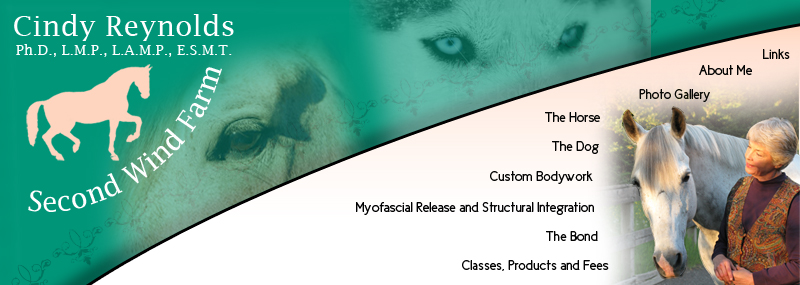
The Horse
Watch this space for topics related to what I do in working with the horse (below, a discussion of the role of the lower neck in straightness).
The basic session:
Depending on what the horse shows me and what the owner tells me, I can use a variety of techniques, including traditional massage techniques, myofascial release, mobilizations of joints, positional releases, the BioScan instrumentation as described below, and others.
I seek throughout to address muscle tension and spasm, and to rebalance the body to help with fatigue, postural compensations, guarding, and pain. The work is directed toward symmetry, freedom of movement, and comfort.
I sometimes discuss the horse's body patterns with the guardian, to see whether there is some daily practical approach the owner can take to improving his movement patterns or keeping him more comfortable.
The BioScan that I use employs pulsed far red and near infrared diodes very intense (but not full laser) light in combination with pulsed magnetic field, each at prescribed frequencies for designated tissues and problems. I encourage you to take a look at the BioScanLight.com website for an appreciation of the power of this unit. It is non-intrusive, extremely effective, and has a long history of use in both animals and humans for improvement of performance.
Gait and posture analysis are an important part of my working evaluation. Lengthening and smoothing fascial tissue to allow the body to balance itself as the muscles are freed is an important part of my treatment. Traditional correct methods of teaching and riding are important to the horse's wellbeing. I encourage as much learning of these methods as possible to help the horse/rider combination.
There are several approaches that I take with horses who are either not comfortable with touch in general or who are chronically tense. I use a relaxation-and-training technique, developed by Jean-Phillipe Giacomini, called EndoTapping. It is a variation of what is called in massage language "tapotement", using the physiology of the muscle to inform and rebalance the horse. See the full discussion of this technique in this website's section 'The Bond'.
As other examples of techniques I like to use, lymphatic facilitation is very useful in speeding healing of surgery, swellings, and injuries; infrasound (note: INFRAsound, waves below the range of hearing) is especially helpful with horses who are extremely guarded because the instrument is used without actually touching the skin.
the low neck, balance, and straightness...
Falling through the shoulder shows up in canter and changes.
When a horse falls through-into-over his inside shoulder in canter (is not 'standing up'), which must be prepared in the preceding gait....
ask why.
Ask because whatever the shoulder does, the low neck is involved. The low neck is the forward rudder and righting machine of the SPINE.
If the low neck (and deep chest and withers, with their vertebrae) is
1) tilted and 'stuck' between the forelegs in a tilt
2) contracted/stuck toward the shoulder blade/elbow
3) stiff one way
4) painful one way
the horse cannot 'stand up' and there will be no straightness, true forward movement, elevation, impulsion, or cadence.
The possibilities for causes are many. No matter the initial cause, distortion results in the many strong and flexible soft tissue connections holding the front of the body to the front limbs. There is no bony connection.
A single foot problem, a joint problem within or above the foot, a difference in leg length left to right, a proprioception defect, handling and riding, all can generate a non-upright lower neck and chest and perpetuate it until the asymmetry can be seen in the chest from below, in the shoulders from above.
The withers, extensions of the spinal vertebrae behind the low neck in the deep chest, can be seen to tilt as the horse stands as well as moves with more weight on one side.
'Snaky necks', poll damage, jaw disorders including teeth and hyoid management, and poorly balanced riding are all part of this non-uprightness and may be contributing primary factors.
Body assessment and body work are absolutely essential to help resolve cases which are not immediately resolved by good riding and correct gymnastic work.
Otherwise, riding correctly is a struggle because some kind of force or distracting technique becomes the focus, while the elements of a correct seat take second place, so it is a vicious cycle, since the crookedness is made worse by a poorer seat; and the horse is unhappy the whole time because he is being forced.
While every support system from trainer to vet to farrier is to be called on to address such a problem, the horse's bodyworker is in the front line. Alignment and myofascial release work help the horse and rider move forward together.
